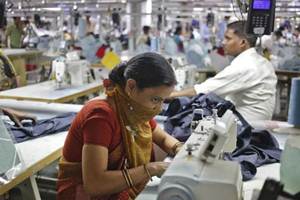Days after the government announced some crucial labour reforms for the garment sector, including the introduction of fixed-term employment and wage parity between contractual and permanent staff, and handed over a Rs 6,000-crore special package, textiles secretary Rashmi Verma says her ministry has written to chief secretaries of states to bring about further labour reforms and allow women to work in garment factories at night. In an interview to Banikinkar Pattanayak, she adds the government is working on proposals to make exit easier for companies, which will help sick textile or garment factories wind down easily. Excerpts:
The Rs 6,000-crore package for the garments sector is aimed at creating 10 million new jobs, $30-billion additional exports (over and above $40 billion in 2015-16) and Rs 74,000-crore investments over the next three years. Are these targets too lofty to be realised?
The targets are realistic. We have calculated 70 jobs on an investment of Rs 1 crore, which is actually a conservative estimate, as the jobs created in the garment sector is normally much higher than this. In fact, in SSI units, it’s 200 on an investment of Rs 1 crore. Only in the organised sector, it’s a little less. But of course, the entire package needs to be implemented in totality for the targets to be realized. Also, when we are talking of jobs and Rs 74,000 crore investment, we are also talking about signing some free trade agreements, like the one with the EU, and the review of certain existing free trade agreement (to suit our interests). So these things are factored in while setting the targets. And if we are able to forge some of the FTAs, like the one with the EU, then certainly, we are going to even exceed the targets. But even without these FTAs, we are hopeful of achieving at least the employment generation target.
[related-post]
Given that the balance sheets of companies are highly stressed and global trade growth forecasts remain weak, will the investment targets be achieved?
Under the Amended Technology Upgradation Fund Scheme, we have raised the (capital) subsidy for the garment sector to 25%, compared with 15% now. So that’s a huge incentive for investment. Also, the industry is highly labour-intensive, and there,too, we are giving support in terms of reimbursing the entire 12% contribution by the employer towards the Employees’ Provident Fund. This will reduce the companies’ wage bill. We are providing some relief in income tax as well, and the duty drawback covering even state levies is a very big incentive (this will cost the exchequer an estimated Rs 5,500 a year). These steps will drive down our cost of production and make our garments more competitive in the global markets vis-à-vis Bangladesh’s or Vietnam’s.
Are the pledges by garment exporters (38 exporters committed to invest only Rs 710 crore and give jobs to 37,720 people in less than a week after the announcement of the package) a muted response?
It’s not really muted, garment players have welcomed the package. It will give a boost to the sector. But yes, they are also looking forward to the FTAs, PTAs etc, which will finally make them truly competitive in the international market.
Now that some important labour reforms are announced, will women also be allowed to work at night at apparel factories?
This is a state subject. So we have written to chief secretaries of various states to allow night shifts for women after ensuring all security and other necessary requirements. Some states like Tamil Nadu, Maharashtra and Gujarat have already allowed night shifts for women. This is a very big measure that boosts earnings of women, who constitute 70% of the garment sector workers.
Will the government amend the archaic Section 25-O of the Industrial Disputes Act to make it easier for sick units close easily, albeit after paying adequate compensation to workers?
In fact, this is being looked into by the department of industrial policy and promotion, as a part of the ‘ease of doing business’ initiatives. The issue of easier exit for companies has been discussed at the highest level — by a committee chaired by the Cabinet secretary as well. So the issue is well under consideration.
When will the fine-prints of the special package be notified?
Fine prints will be out within a couple of months. It will be just specifying the guidelines, etc. But the intention and various aspects of the scheme have already been explained to the (export promotion) councils and they are happy about it.


